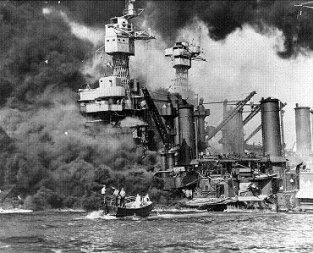![]() The Pacific War Online Encyclopedia
The Pacific War Online Encyclopedia
|
| Table of Contents |
 Naval Historical Center #80-G-19930 |
National Archives. Via Wikipedia Commons |
The Pacific War (Japanese: Dai Tō-A Sensō, "Greater East Asia War") was fought between the Japanese Empire and the United States and their allies from 7 December 1941 to 15 August 1945. The war began with the surprise attack on Pearl Harbor and simultaneous landings in Malaya, though its origins can be traced back much earlier. The war ended with the nuclear attacks on Hiroshima and Nagasaki and the Russian offensive in Manchuria, which, together with the submarine blockade, finally forced the Japanese to surrender.
The articles at this site contain information on many aspects of the Pacific War,
including descriptions of important battles, ships,
aircraft,
installations, and
commanders.
Individual articles can be quickly located from the Table of Contents.
Because this encyclopedia was originally
developed as an
online
database to accompany a Pacific War computer war game, there
is more than the usual emphasis on the technical, logistical and
geographical
aspects of the Pacific War. Geographical locations include
most
significant locales between 70E and 110W longitude and 55S and 65N
latitude. An attempt has been made to provide comprehensive
information
on flag and general officers, with fewer entries for civilians or
military
persons of lesser rank.
Western personal names are given as Family, Given M.I. while Japanese and Chinese names are listed as Family Given, omitting the comma, which reflects Oriental usage. Thus, the principal antagonists at the Battle of Midway are listed as Fletcher, Frank Jack and Nagumo Chuichi.
Because most writings relevant to the Pacific War have used the Wade-Giles romanization of Chinese place names, which was in widespread use in the 1940s, these are used here in preference to the Hanyu Pinyin romanization that has been adopted more recently. However, the Hanyu Pinyin romanizations are given in the article on each such location.
Unless otherwise noted, all digital
maps are
generated from
the DTED Level 0 data published by the National
Geospatial-Intelligence
Agency or SRTM3 v.2 data from the National
Aeronautics and Space Administration. Both data sets are in the
public
domain. The digital
renderings
themselves are © 2006-2013 by Kent G. Budge. All other images
are
duly
credited and, to the best of my knowledge and belief, are in the public
domain unless otherwise noted. Where a image caption includes the
phrase "Fair use may apply," the image is both historically
unique and old enough that copyright has likely expired, but I claim
fair use for this educational website if the image is in fact still
under copyright.
We have adopted the convention of putting the names of Japanese land and air units in italics to distinguish them from Allied units. No such convention is felt necessary for ships, whose names are usually a clear indication of nationality.
Dates and units of measure are problematic when writing for an international audience. Dates are written out in full or abbreviated using the standard ISO format, year-mm-dd. Most lengths and weights are given in both English and metric units. Ship speeds are measured in knots. Other units are discussed under Logistics.
If you are looking for information on a specific topic, you may look for that topic in the Table of Contents, or you may use the search box found at the top right of every page in the Encyclopedia.
If you are interested in the general history of the Pacific War, a good starting place is the Chronology. This includes links to many other articles that give more in depth information on important campaigns and other events of the war.
If you are interested in the geography of the Pacific War, a good starting place is the Master Map. This is a clickable map of the Pacific that will take you to the article on each important geographic area.
If you are interested in technology, the articles on Aircraft and Ships are good starting places.
These articles link articles on specific categories of aircraft and
ships, which in turn link to articles on individual aircraft types and
ship classes. These articles in turn have links to the weapons and
sensors used by these combat platforms. You may also go directly to the
articles on guns, radar, sonar, and bombs for listings of articles on specific weapons and sensors.
Many visitors are interested in order of battle information for the
Pacific War. You will find orders of battle for specific battles and
campaigns at most of the relevant articles. If you are interested in a
complete order of battle for the war, you will find links to master
orders of battle for the major powers that fought in the Pacific at the Order of Battle article.
Alphabetic listing of all articles in the Pacific War Online Encyclopedia
Bulletin board for discussing the Pacific War and the Pacific War Online Encyclopedia. This is also where I post announcements regarding the encyclopedia.
Among other things, these tell you where I'm coming from.
I've gotten some very useful tips by email. If you send materials such as digital photographs,
please tell me about the copyright status and (if you hold the
copyright) whether I have permission to reproduce the material in the
encyclopedia.
The Pacific War Online Encyclopedia © 2007-2013 by Kent G. Budge. Index